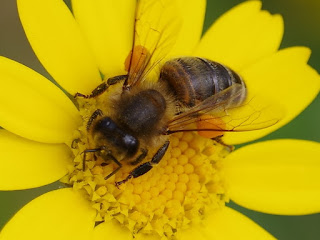A Robin in the Rose Garden sang beautifully from the top of a rose bush.
Starlings waited on the roof of the Lido restaurant to swoop down on scraps.
There was a handsome variegated Feral Pigeon under a tree.
The odd couple of a Herring Gull and a Lesser Black-Backed Gull had a young gull with them, occasionally begging as if they were its parents and it was a hybrid. There are several mid-grey gulls on the lake that could possibly be hybrids of this kind. The offspring of these two closely related species are fertile, so there are all kinds of possibilities for intermediate forms.
A Black-Headed Gull boldly challenged a young Herring Gull for a bit of flatbread. Of course the bigger bird won.
Another young Herring Gull finished the remains of the pigeon killer's breakfast. The pigeon killer and his mate were away, probably looking for lunch in a new place where the pigeons were less wary and easier to catch. An ominous (and inaccurate) weather forecast had kept people out of the park and no one was feeding the birds in his usual place, so there were few pigeons there either.
A first year Black-Headed Gull had a brisk wash and flap.
The familiar EZ73323 stared out from his usual post beside the Serpentine.
The youngest Great Crested Grebes on the lake were making an unstoppable racket, one pursuing each parent. Their father took no notice. They are fed enough and are doing very well.
One of the two Bar-Headed x Greylag Goose hybrids that regularly visit the park took advantage of the small number of people to go up on the Parade Ground and eat some better grass that the scrawny stuff that grows next to the lake.
The Mallard family on the Round Pond, which survived against all odds, are now almost grown up.
There was a huge number of Pochards on the Long Water, almost all drakes -- the sexes migrate separately, but even when both are present males heavily outnumber females.
A Common Wasp (right) and its mimic, the hoverfly Myathropa florea, were side by side on an ivy flower. It's not really a very good mimic and even the human eye can easily tell them apart at a distance. Probably many birds can too, but even the slightest resemblance to a venomous species can help in the struggle to survive.
The hoverfly Eristalis pertinax does a better job of mimicking a dark Honeybee.
There wasn't a Honeybee on the ivy to compare, so here's a picture I took a while ago of one on a marigold.
The arbutus tree near the bridge attracted a Buff-Tailed Bumblebee.
The tree flowers in the autumn at the same time as its very slow developing fruits ripen. They both look slightly like and taste faintly of strawberries, hence the popular name 'strawberry tree'.
Pliny the Elder in his Natural History advised against keeping Honeybees near an arbutus, as the flowers make bitter tasting honey.













Pedant's corner. Venomous, rather than poisonous.
ReplyDeleteI found you can reach out and touch honeybee mimic hoverflies feeding, and once when I went to eject a honeybee mimic hoverfly that had come in through a window I temporarily lost it among my fingers, it was so relaxed. Jim
Thanks. How curious about the hoverflies. Will try this the next time I see one busy feeding.
DeleteLovely to see all those Pochard- very much a declining species in the UK.
ReplyDeleteAmazed you got to see so many insects given the weather, though in the afternoon I walked to the local Perivale Park where the Brent had burst its banks giving us an extensive wetland, but did see a Small white, Common Blue Damselfly & several Common Carder Bees at Black Horehound.
At a previous monthly count I got 61 Pochard. The migrant flock has built up over the years. They like lurking under the overhanging bushes beside the Long Water.
DeleteThe attraction for insects seems to be that there's a long uninterrupted wall of ivy growing up the fence and hedge at the back of the Lido, with a patch of mixed wildflowers growing under it. A decent selection of hoverflies but still no sign of an Ivy Bee.
Boars do get off-their-face drunk eating the fruit of arbutus, for real.
ReplyDeleteBrave little Black-Headed Gull! It only goes on to show that the only limiting factor in a gull's penchant for evil doing is its relative size.
Happy to hear the Robin! Looking very forward to hearing our first Robins of the year soon.
Glad I've never had a face a drunken boar. Our arbutus fruits mostly get eaten by parakeets while still on the tree, so they don't get a chance to ferment.
DeleteI have a photo of an extraordinary bird feeding at my balcony behind Caroline House W2 4RQ.
ReplyDeleteWould you identify? And how do I send it?
Please send it as an attachment to an email, to the address at the top right of the main page of the bog.
Delete